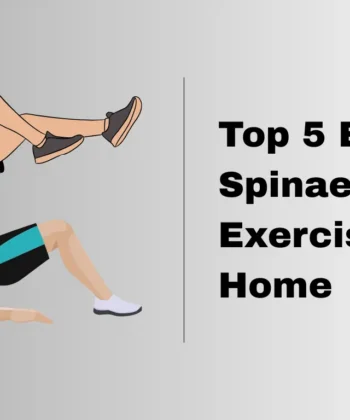
Table of Contents
Have you ever felt like controlling your breathing is harder than it should be? It’s not just you. While breathing happens naturally, few people realize its true power—a key to mental clarity, energy, and inner peace.
This is where Kriya Yoga breathing techniques come in. Kriya yoga breathing is a sacred practice beyond regular breathwork and leads you to inner peace and spiritual awakening.
The technique has its roots in the centuries-old Kriya Yoga tradition, revived in modern times by Mahavatar Babaji, and its origins are linked to great gurus. More than just breathwork, it’s a wonderful way to harmonize your body, mind, and soul while tapping into the incredible power that lives within you.
Why Practice Kriya Yoga Breathing?
We all breathe constantly, yet very few of us can utilize it to its full potential. Kriya Yoga breathing teaches us how to breathe with awareness—slowly and mindfully, opening up the ocean of energy and healing within us.
With Kriya Yoga breathwork, each inhalation and exhalation becomes an opportunity to:
- Calm your mind & reduce stress
- Improve digestion, immunity & energy levels
- Enhance focus & emotional balance
- Deepen self-awareness & spiritual connection
- Improved lung capacity
The best part? This practice is open to all, it does not require any special location or equipment. Whether you’re at home, at work, or just sitting on a park bench, your breath is always with you—ready to heal, energize, and transform your life.
Guided Meditations to Prepare for Kriya Yoga
Yes, Kriya Yoga is no secret. You’ll find countless YouTube videos, online articles, and books on the subject. But if you’re truly seeking transformation, nothing compares to direct guidance from a realized sage. That, my friend, is the real shortcut to mastering Kriya Yoga.
Kriya yoga focuses on the intense connection between your breath and mind, with the concept that controlling the breath leads to self-mastery. Today’s practice begins with an easy breathing method before rolling on to detailed step breathing methods. Although the session usually finishes with a 25-35 minute pranic energization method, we will concentrate on the basics in this post.
Settling into Stillness (2-3 Minutes)
- Sit in a meditative posture that is comfortable for you, such as Padmasana (Lotus Pose), Siddhasana (Perfect Pose), or Vajrasana (Thunderbolt Pose).
- Maintain optimal alignment of your head, neck, and spine.
- Gently roll your shoulders back and down to relax them.
- Place your hands on your knees, palms facing upwards, and sit in Jnana Mudra or just relax pleasantly.
- Gently move your chin toward your chest to stretch the back of your neck.
Close your eyes and move your awareness inward. Take a deep breath and exhale gently. Let go of any stress in your body. Keep your natural breathing without changing it. Just be present.
Note: Pause for a few breaths
Ujjayi Breathing– The Victorious Breath (3-5 Minutes)
Let’s now roll on to Ujjayi breathing, usually referred to as the breath of victory. This breathing calms the nervous system and trains the mind for deep meditation.
- Step 1: Create Jalandhara Bandha (chin lock) by bringing your chin slightly toward your chest.
- Step 2: Move your tongue around inside your mouth, lightly touching the upper palate. No force is needed; let it rest comfortably
- Step 3: Focus your attention on the back of your throat.
- Step 4: Breathe in slowly and deeply through your nose, gently contracting your throat so that the breath sounds like the ocean. Let this sound to come naturally—don’t force it.
- Step 5: Exhale completely through your nose, keeping your throat contracted.
Take a deep breath and listen to the sound of the ocean within you. Exhale and let go of all distractions. Continue this steady, rhythmic breathing.
Note: Pause and allow a few minutes of practice
Connecting with Divine Energy (Chanting & Prayer – 3 Minutes)
Place your palms gently on your heart center in anjali mudra (namaste pose). Breathe in deeply. Chant Om as you exhale.
- Inhale… “Ommmm…”(Long, resonant chant)
- Inhale again… “Ommmm…”(Feeling the vibration)
- Inhale one more time… “Ommmm…”(Allowing the mind to settle)
We will now say a short prayer for heavenly guidance and inner understanding.
Chant the Kriya Yoga Meditation Prayer:
🕉 Om Sahana Vavatu (May we all be shielded.)
🕉 Sahanau Bhunaktu (May we all be nourished together.)
🕉 Saha Viryam Karavavahai (May we build each other’s strength)
🕉 Tejasvi Navaditamastu (May light and brilliance flood our studies.)
🕉 Ma Vidvishavahai (May we not be hostile to one another.)
🕉 Om Shanti Shanti Shantihi (Om peace, peace, peace)
Note: Pause for a moment of stillness
Integration (1-2 Minutes)
Now take a deep breath, then exhale slowly and bow your hands in gratitude.
Take a deep breath and stand up straight. Sit quietly for a few seconds and feel the peace inside you. When you are ready, slowly open your eyes.
Step-by-Step Guide to Kriya Yoga Breathing Techniques
1. Kapalabhati
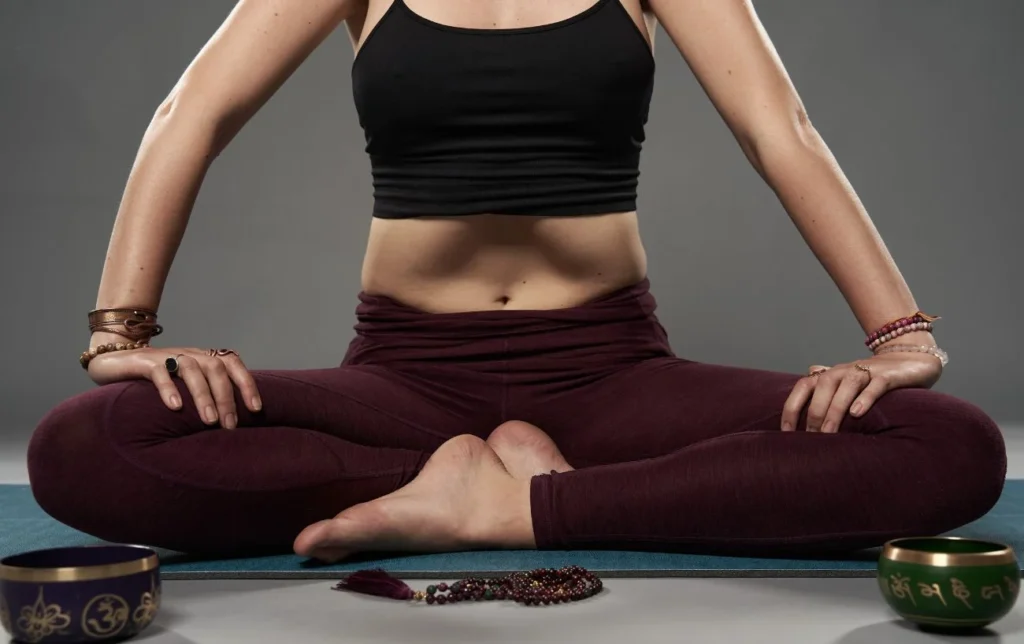
Kapalabhati, or ‘shining skull breath’, is a powerful Kriya Yoga technique to purify the body and mind, activate the nervous system, and enhance meditation. Let’s start with step-by-step instructions.
Understanding Kapalbhati and Safety Measures
Kapalabhati is a cleansing breathing technique that begins with a series of quick, strong exhalations through the nose, followed by a natural inhalation. The abdominal muscles are tightened inward to emphasize the forceful exhalation.
Who should avoid this practice?
- If you’re pregnant, menstruating, or under the age of 12, avoid the traditional option.
- If you have high blood pressure, ulcers, hernias, heart problems, seizures, or stomach swelling, practice gently or talk to your teacher.
Kapalbhati Breathing Practice
1. Basic Kapalbhati Variation (For Beginners & General Practice)
Let’s start with a simple option that works for everyone.
- Take a deep breath and allow your breath to inhale naturally by gently contracting your throat as you exhale.
- Maintain a regular flow, keeping your breaths in and out consistent.
Now, we will take 50 breaths in 3 rounds. If you are new, you can start with 10-20 breaths in each round. Let’s get started.
(Guided rhythm: start slowly, gradually increase speed.)
“Inhale, exhale, exhale…” Keep up the pace.
(After 50 breaths)
Take a deep breath. Tuck your chin slightly towards your chest (Jalandhara Bandha) and hold your breath for 10 counts (pause). After exhaling comfortably, start breathing normally.
(Pause for 30 seconds)
“Let’s begin Round 2…”
Note: Repeat the process for 2 more rounds
2. Traditional Kapalbhati Variation (For Experienced Practitioners)
If you feel comfortable, you can now move on to traditional Kriya Yoga, which requires deeper abdominal exercises.
- This time, place your hand on your abdomen.
- With each emphatic exhale, purposely pull your navel toward your spine.
- Inhales remain passive and natural.
- We will do 3 rounds, taking 50 breaths in each round.
Note: Through 3 rounds, pausing in between for breath and relaxing
Integration
Take a deep breath in and exhale slowly. Let your breathing return to a normal rhythm.
Sit still for a few seconds and pay attention to the feelings in your body. You may experience lightness, warmth, or free-flowing energy.
Place your palms at your heart center in Anjali Mudra. Take a deep breath. And chant Om as you exhale.
(Chant Om 3 times)
Gently bow your head and express gratitude. Slowly open your eyes. Your practice is complete.
2. Dog Breathing (Panting Breath) – 2 Rounds (30 Seconds Each)
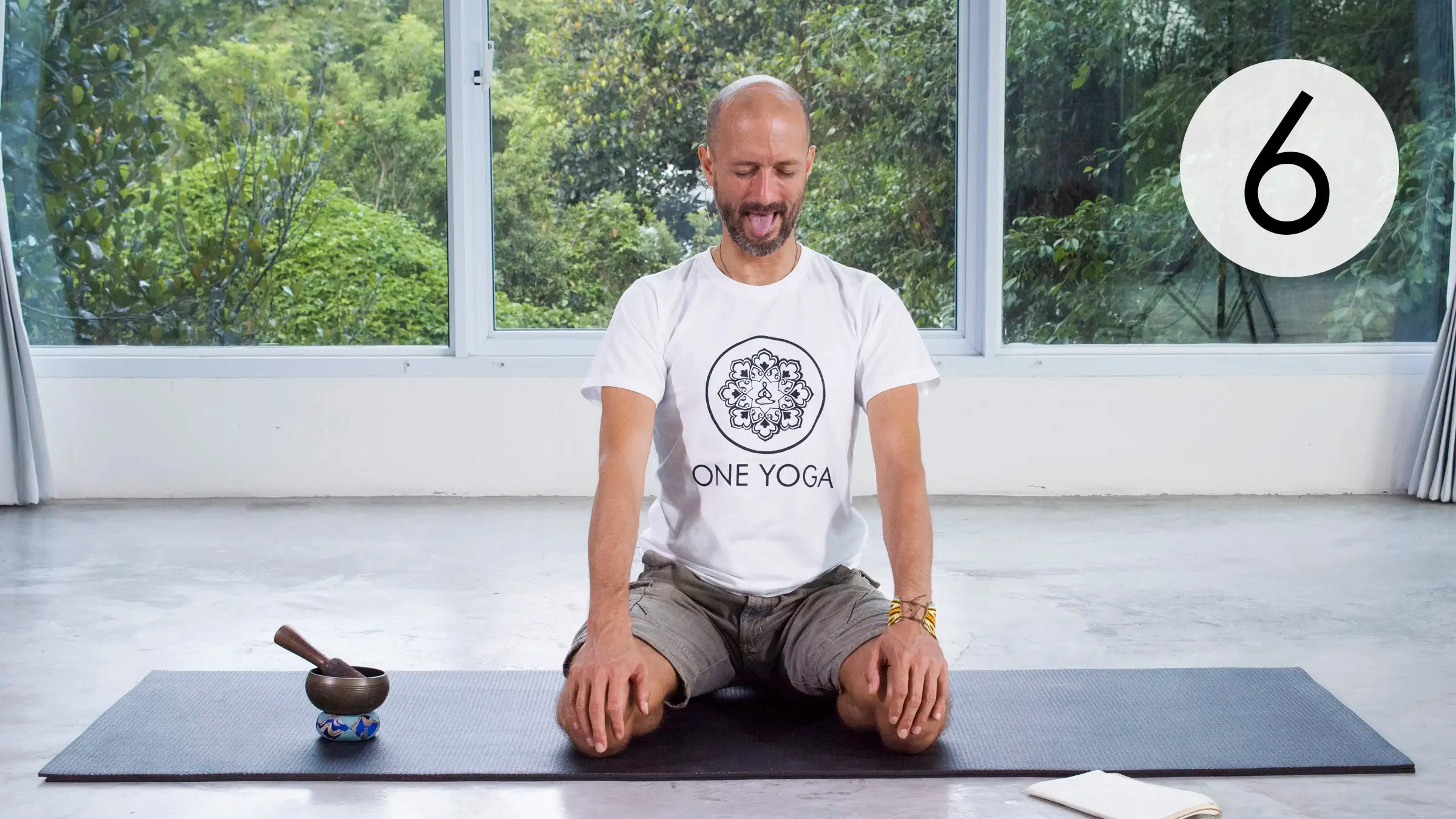
- Sit in Vajrasana (Thunderbolt pose), keeping your knees together and heels back.
- Gently place your hands on the knees and bend forward slightly.
- Open your mouth wide and stick your tongue out as far as possible.
When you feel comfortable, close your eyes and take a deep breath through your nose. As you exhale, start panting like a dog. Each breath stimulates the abdomen.
Round 1
Now, start panting. Keep breathing out. Keep the beat consistent. Feel your abdomen contracting with each exhale.
(Continue for 30 seconds)
Take a deep breath, hold it for a while, and then release it slowly. Relax.
(Pause for 10 seconds)
Note: Repeat Round 2 for another 30 seconds
3. Rabbit Breathing – 2 Rounds (30-40 Breaths Each)
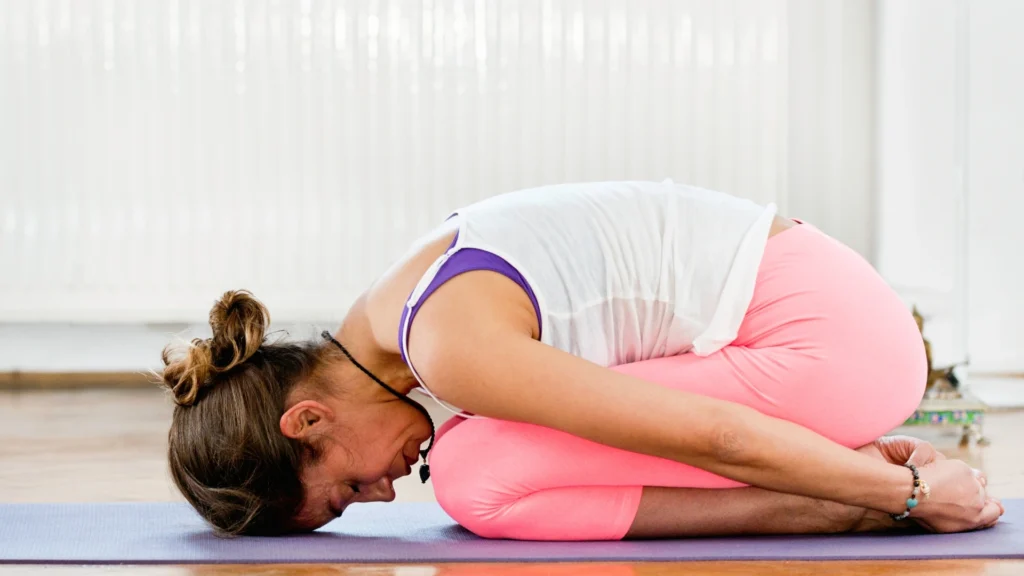
- Remain in Vajrasana, but now bend forward and place your elbows and forearms on the mat in front of you.
- Keep your head, shoulders, and hips in one line.
- Open your mouth slightly, allowing the tip of your tongue to come into touch with your lower lip.
Round 1
Breathe rapidly, steadily, and continuously. Keep your breathing light and smooth. Feel the breath move through the thoracic region, expanding the chest with each breath in.
(Continue for 30-40 breaths)
Take a deep breath and exhale slowly. Relax in Sasangasana (Rabbit Pose) for a few breaths.
Note: Repeat the same process for Round 2.
4. Mandukasana (Frog Pose) – 5 Rounds
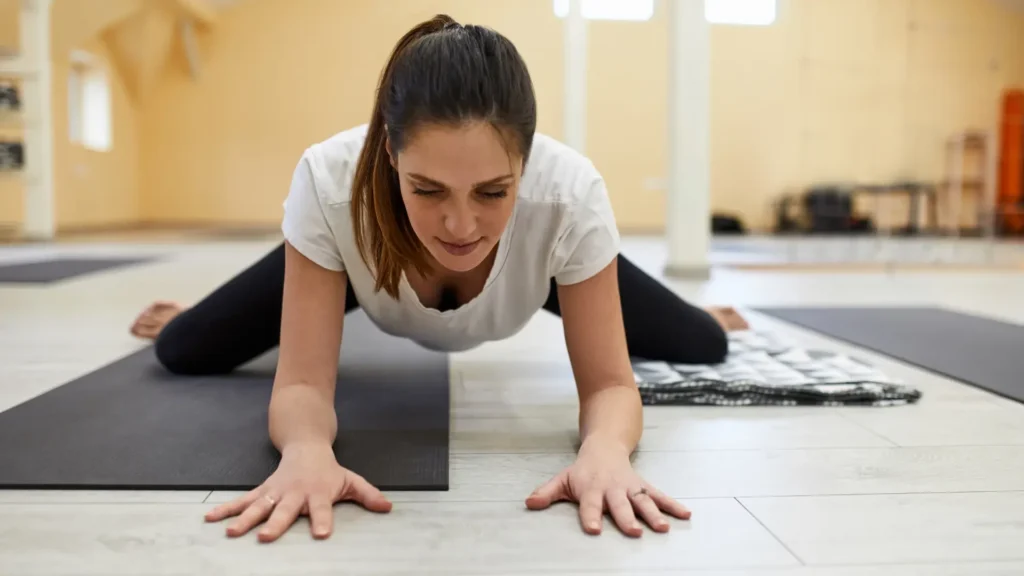
Practicing Mandukasana (Frog Pose) helps stretch the hips, strengthen the lower back, and improve digestion. If you have high blood pressure, gastrointestinal problems, or vision problems, you can practice equal breathing (deep inhalation and exhalation) in Vajrasana.
- Sit in Vajrasana (Thunderbolt pose), keeping your knees together and heels back.
- Retain an upright spine, relaxing shoulders, and hands on your thighs.
- Place both fists on your lower abdomen, just below the navel, with thumbs facing up.
- Take a deep breath and exhale by bending forward and gently pressing your fists on your stomach.
- Keep your head aligned with your spine and avoid bending your back.
Take a deep breath, then be prepared to hold it for a count of 5.
Round 1
Take a deep breath. As you exhale, press your hands gently into your stomach and lean forward slightly. Hold for a count of 5.
Slowly come back to Vajrasana and take a deep breath.
Note: Repeat the process for 5 Rounds
To balance the stretch, we’ll do a lighter counterpose.
- Place your hands on your knees and expand your chest by gently arching your back.
- Tilt your chin slightly upward to give a gentle stretch to the spine and abdomen.
- Hold for 5 counts.
Slowly come back to Vajrasana and take a few deep breaths.
5. Nadi Shuddhi (Alternate Nostril Breathing) – 5 Minutes
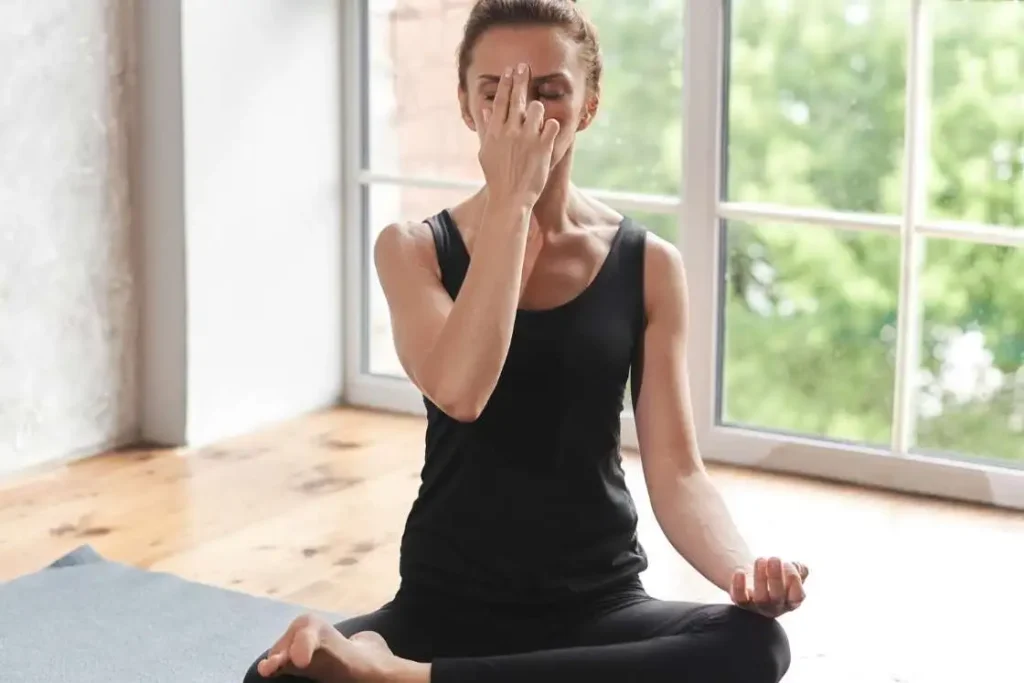
- Sit in a comfortable meditative pose, such as Padmasana (Lotus Pose) or Siddhasana (Perfect Pose).
- Keep your shoulders loose and your spine upright.
- Place both hands on the knees with the palms facing upwards.
Shut your eyes while taking a couple of deep breaths. Breathe in deeply and exhale slowly.
- Place the right hand in Vishnu Mudra (fold the index and middle finger, leaving thumb, ring finger, and little finger extended).
- Close your right nostril using your thumb and breathe in through the left nostril.
- Exhale through the right nostril after closing your left nostril with your ring finger.
- After inhaling, close your right nostril, then release it through the left nostril.
This completes 1 round. Continue for 5 minutes, allowing your breathing to become steady and rhythmic.
Closing
Gently bring your attention back to your breath. Come back to your body. Come back to the present.
Join your palms in the center of your heart. Chant Om while breathing deeply in and out.
Bow your head slightly in gratitude. You have completed your Kriya Yoga breathing exercise.
Also Read: How to Do Middle Splits Without Pain
Also Read: How to Practice Kundalini Yoga at Home
Also Read: 10 Minute Morning Yoga for Beginners at Home



